
Concept explainers
Propose a structure consistent with each set of data.
a. a compound that contains a benzene ring and has a molecular ion at
b. a hydrocarbon that contains only
c. a compound that contains a carbonyl group and gives a molecular ion at
d. a compound that contains
(a)
Interpretation: The structure of a compound that contains a benzene ring and has a molecular ion at
Concept introduction: Molecular mass is the sum of the atomic weights of each constituent element multiplied by the number of atoms of that element.
Answer to Problem 13.37P
The structure of the compound that contains a benzene ring and has a molecular ion at
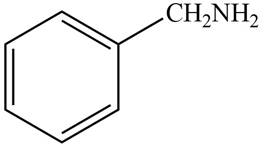
Explanation of Solution
The molecular ion peak of a compound is observed at
Possible hydrocarbons are calculated as,
• Divide
Thus, the possible molecular formula is
The molecular ion has odd mass. Thus, the compound may contain
Possible compounds with
• Substitute
Thus, the possible molecular formula is
The molecular mass of
Hence, the structure of a compound that contains a benzene ring and has a molecular ion at
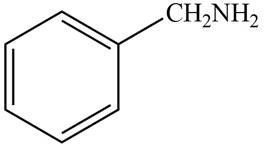
Figure 1
The structure of a compound
(b)
Interpretation: The structure of a hydrocarbon that contains only
Concept introduction: Molecular mass is the sum of the atomic weights of each constituent element multiplied by the number of atoms of that element.
Answer to Problem 13.37P
The structure of a hydrocarbon
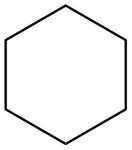
Explanation of Solution
The molecular ion peak of a compound is observed at
Possible hydrocarbons are calculated as,
• Divide
• Replace one carbon by
Thus, the possible molecular formula is
The molecular mass of
Hence, the structure of a hydrocarbon that contains only
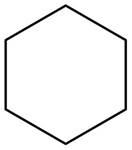
Figure 2
The structure of a hydrocarbon
(c)
Interpretation: The structure of a compound that contains a carbonyl group and gives a molecular ion at
Concept introduction: Molecular mass is the sum of the atomic weights of each constituent element multiplied by the number of atoms of that element.
Answer to Problem 13.37P
The structure of a compound
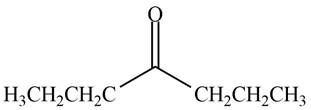
Explanation of Solution
The molecular ion peak of a compound is observed at
Possible hydrocarbons are calculated as,
• Divide
• Replace one carbon by
The compound that contain
Possible compounds with
• Substitute
Thus, the possible molecular formula is
Hence, the structure of a compound that contains a carbonyl group and gives a molecular ion at
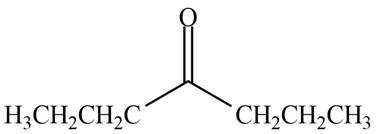
Figure 3
The structure of a compound
(d)
Interpretation: The structure of a compound that contains
Concept introduction: Molecular mass is the sum of the atomic weights of each constituent element multiplied by the number of atoms of that element.
Answer to Problem 13.37P
The structure of a compound
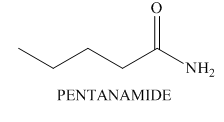
Explanation of Solution
The molecular ion peak of a compound is observed at
Possible hydrocarbons are calculated as,
• Divide
• Replace one carbon by
The given compound contains
Possible compounds with
• Substitute
• Substitute
Thus, the possible molecular formula is
Hence, the structure of a compound that contains

Figure 4
The structure of a compound
Want to see more full solutions like this?
Chapter 13 Solutions
Organic Chemistry
Additional Science Textbook Solutions
Physics for Scientists and Engineers
Campbell Essential Biology with Physiology (5th Edition)
Applications and Investigations in Earth Science (9th Edition)
Genetics: From Genes to Genomes
Physics of Everyday Phenomena
- 151.2 254.8 85.9 199.6 241.4 87.6 242.5 186.4 155.8 257.1 242.9 253.3 256.0 216.6 108.7 239.0 149.7 236.4 152.1 222.7 148.7 278.2 268.7 234.4 262.7 283.2 143.6 QUESTION: Using this group of data on salt reduced tomato sauce concentration readings answer the following questions: 1. 95% Cl Confidence Interval (mmol/L) 2. [Na+] (mg/100 mL) 3. 95% Na+ Confidence Interval (mg/100 mL)arrow_forwardResults Search Results Best Free Coursehero Unloc xb Success Confirmation of Q x O Google Pas alekscgi/x/lsl.exe/1o_u-IgNslkr 7j8P3jH-IQs_pBanHhvlTCeeBZbufu BYTI0Hz7m7D3ZcHYUt80XL-5alyVpwDXM TEZayFYCavJ17dZtpxbFD0Qggd1J O States of Matter Using a phase diagram to find a phase transition temperature or pressure Gabr 3/5 he pressure above a pure sample of solid Substance X at 101. °C is lowered. At what pressure will the sample sublime? Use the phase diagram of X below to nd your answer. pressure (atm) 24- 12 solid liquid gas 200 400 temperature (K) 600 ote: your answer must be within 0.15 atm of the exact answer to be graded correct. atm Thanation Check © 2025 McGraw Hill LLC. All Rights Reserved. Terms of Use | Privacy Center I Q Search L³ ملةarrow_forward301.7 348.9 193.7 308.6 339.5 160.6 337.7 464.7 223.5 370.5 326.6 327.5 336.1 317.9 203.8 329.8 221.9 331.7 211.7 309.6 223.4 353.7 334.6 305.6 340.0 304.3 244.7 QUESTION: Using this group of data on regular tomato sauce concentration readings answer the following questions: 1. 95% Cl Confidence Interval (mmol/L) 2. [Na+] (mg/100 mL) 3. 95% Na+ Confidence Interval (mg/100 mL)arrow_forward
- Search Results Search Results Best Free Coursehero Unlo x b Success Confirmation of Q aleks.com/alekscgi/x/sl.exe/10_u-lgNslkr7j8P3jH-IQs_pBan HhvlTCeeBZbufu BYTIOHz7m7D3ZcHYUt80XL-5alyVpwDXM TEZayFYCav States of Matter Using a phase diagram to find a phase transition temperature or pressure Use the phase diagram of Substance X below to find the temperature at which X turns to a gas, if the pressure above the solid is 3.7 atm. pressure (atm) 0. 32- 16 solid liquid gas 200 temperature (K) Note: your answer must be within 20 °C of the exact answer to be graded correct. Дос Xarrow_forwardConsider the reaction below to answer the following questions: Acetoacetic ester can be prepared by the Claisen self-condensation reaction of ethyl acetate. 1. NaOEt, EtOH H&C OCH CH3 2 H30 H3C CH2 OCH2CH3 A. Write the complete stepwise mechanism for this reaction. Show all electron flow with arrows and draw all intermediate structures. B. Ethyl acetate can be prepared from ethanol as the only organic starting material. Show all reagents and structures for all intermediates in this preparation. C. Give the structures of the ester precursors for the following Claisen condensation product and formulate the reaction. OEtarrow_forwardUse the phase diagram of Substance X below to find the temperature at which X turns to a gas, if the pressure above the solid is 3.7 atm. pressure (atm) 32 16 solid liquid gas 0 0 200 temperature (K) Note: your answer must be within 20 °C of the exact answer to be graded correct. Шос ☑ كarrow_forward
- Starting from bromoethane, how could you prepare the following compounds: a. Ethanol. b. Acetaldehyde f. Acetone. e. 2-Propanol i. Acetoacetic ester. d. 2-Bromoacetic acid. c. Acetic acid g. Acetamide. j. Ethylmalonate k. Gama ketoacid. h. Ethyl magnesium bromide.arrow_forward- The pressure above a pure sample of solid Substance X at 60. °C is raised. At what pressure will the sample melt? Use the phase diagram of X below to find your answer. pressure (atm) 02 0.4 solid Hliquid gas 0 0 200 400 600 temperature (K) Note: your answer must be within 0.025 atm of the exact answer to be graded correct. ☐ atmarrow_forward15. What is the order of decreasing reactivity towards nucleophilic acyl substitution for the carboxylic acid derivatives? (most reactive first) 0 O H3C COC CH3 H₂C C N(CH3)2 H3C C OCH3 A. a. I, 11, 111, b. I, III, IV, II C. II, IV, III, I ° (CH3)2CH C OCH3 IV d. II, I, III, IV B. R COCR 0 0 0 13= RC NH2 RC OR RC CI === IV a. I, III, II, IV b. II, III, I, IV C. III, II, I, IV d. IV, I, III, IIarrow_forward
- Draw the formula of the product obtained by reacting D-Tallose with bromine water.arrow_forwardChoose the best reagent(s) for carrying out the following conversions from the list below. Place the letter corresponding to the best choice in the blank to the left of the conversion. a. KMnO4, H3O+ b. Tollens' Reagent [oxidizing reagent] C. NaBH4, ethanol d. 1. BH3 2. H3O+ e. 1. CH3MgBr, ether 2. H3O+ f. CrO3, H2SO4, H₂O g. 1. Mg, ether 2. CO2 3. H3O+ h. 1. NaCN 2. H2SO4, H2, heat i. O3, then Zn and HOAC j. CH₂I A. B. C. CH CH=CHCH2COOH Br CEN CH COOH + HOOCCH COOH COOH 010 CH3arrow_forwardDraw the structures for each of the intermediates in the boxes provided for the synthesis below. OCH3 Fe HO HNO (CHOO pynding H₂504 LHNO2 NACH-I Fa H₂O HCL HNO 180arrow_forward

 Organic Chemistry: A Guided InquiryChemistryISBN:9780618974122Author:Andrei StraumanisPublisher:Cengage Learning
Organic Chemistry: A Guided InquiryChemistryISBN:9780618974122Author:Andrei StraumanisPublisher:Cengage Learning

